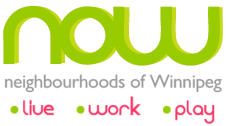 First and Largest Local Government Site to Exclusively Embrace Semantic Technologies
First and Largest Local Government Site to Exclusively Embrace Semantic Technologies
The City of Winnipeg, the capital and largest city of Manitoba, Canada, just released its “NOW” portal celebrating its diverse and historical 236 neighborhoods. The NOW portal is one of the largest releases of open data by a local government to date, with some 57 varied datasets now available ranging from local neighborhood amenities such as pools and recreation centers, to detailed real estate and economic development information. Nearly one-half million individual Web pages comprise the site, driven exclusively by semantic technologies. Nearly 10 million RDF triples underly the site.
In announcing the site, Winnipeg Mayor Sam Katz said, “We want to attract new investment to the city and, at the same time, ensure that Winnipeg remains healthy and viable for existing businesses to thrive and grow.” He added, “The new web portal, Neighbourhoods of Winnipeg—or NOW—is one way that we are making it easy to do business within the City of Winnipeg.”
NOW provides a single point of access for information such as location of schools and libraries, Census and demographic information, historical data and mapping information. A new Economic Development feature included in the portal was developed in partnership with Economic Development Winnipeg Inc. (EDW) and Winnipeg REALTORS®.
Our company, Structured Dynamics, was the lead contractor for the effort. An intro to the technical details powering the Winnipeg site is provided in the complementary blog post by SD’s chief technologist, Fred Giasson. These intro announcements by SD will be later followed by more detailed discussions on relevant NOW portal topics in the coming weeks.
Background and Formal Release
But the NOW story is really one of municipal innovation and a demonstration of what a staff of city employees can accomplish when given the right tools and frameworks. SD’s real pleasure over the past two years of development and data conversion for this site has been our role as consultants and advisors as the City itself converted the data and worked the tools. The City of Winnipeg NOW (Neighbourhoods of Winnipeg) site is testament to the ability of semantic technologies to be learned and effectively used and deployed by subject matter professionals from any venue.
In announcing the site on May 13, Mayor Sam Katz also released a short four-minute introductory video about the site:
What we find most exciting about this site is how our open source Open Semantic Framework can be adopted to cutting-edge municipal open data and community-oriented portals. Without any semantic technology background at the start of the project, the City has demonstrated its ability to manage, master and then tailor the OSF framework to its specific purposes.
Key Emphases
As its name implies, the entire thrust of the Winnipeg portal is on its varied and historical neighborhoods. The NOW portal itself is divided into seven major site sections with 2,245 static pages and a further 425,000 record-oriented pages. The number of dynamic pages that may be generated from the site given various filtering or slicing-and-dicing choices is essentially infinite.
Neighborhoods
The fulcrum around which all data is organized on the NOW portal are the 236 neighborhoods within the City of Winnipeg, organized into 14 community areas, 15 political wards, and 23 neighborhood clusters. These neighborhood references link to thousands of City of Winnipeg and external sites, as well as have many descriptive pages of their own.
Some 57 different datasets contribute the information to the site, some authored specifically for the NOW portal with others migrated from legacy City databases. Coverage ranges from parks, schools, recreational and sports facilities, and zoning, to libraries, bus routes, police stations, day care facilities, community gardens and more. More than 1,400 attributes characterize this data, all of which may be used for filtering or slicing the data.
Property and Economic Development
A key aspect of the site is its real estate, assessment and zoning information. Every address and parcel in the city — a count nearing 190,000 in the current portal — may be looked up and related to its local and neighborhood amenities. Up to three areas of the City may be mapped and compared to one another, felt to be a useful tool for screening economic development potentials.
Census Data
All of the neighborhood and neighborhood clusters may be investigated and compared for Census data in two time periods (2001 and 2006). Types of Census informaton includes population, education, labor and work, transportation, education, languages, income, minorities and immigration, religion, marital status, and other family and household measures.
Any and all neighborhoods may be compared to one another on any or all of these measures, with results available in chart, table or export form.
Images and History
Images and history pages are provided for each Winnipeg neighborhood.
Mapping
Throughout, there are rich mapping options that can be sliced and displayed on any of these dimensions of locality or type of information or attribute.
More to Come!
The basic dataset authoring framework will enable City staff (and, perhaps, external parties or citizens) to add additional datasets to the portal over time.
Key Functionality and Statistics
The NOW site is rich in functionality and display and visualization options. Some of this functionality includes the:
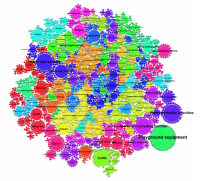
|
NOW Graph StructureNOW is entirely an ontology-driven site, with both domain and administrative ontologies guiding all aspects of search, retrieval and organization. There are 12 domain ontologies govering the site, two of which are specific to NOW (the NOW ontology and a Canadian Census ontology). Ten external ontologies (such as FOAF, GeoNames, etc) are also used. The NOW ontology, shown to the left, has more than 2500 subject concepts within it covering all aspects of municipal governance and specific Winnipeg factors. |
||
Relation BrowserAll of the 2500 linked concepts in the NOW ontology graph can be interactively explored and navigated via the relation browser. The central “bubble” also presents related, linked information such as images, Census data, descriptive material and the like. As adjacent “bubbles” are clicked, the user can navigate or “swim through” the NOW graph. |
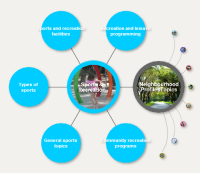
|
||
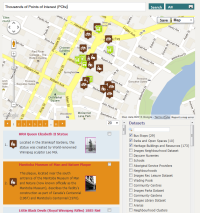
|
Web MapNearly all of the information on the NOW site — or about 420,000 records — contains geolocational information of one form or another. There are about 200,000 points of interest records, another 200,000 area or polygon records, and about 7,000 paths and routes such as bus routes in the system. All 190,000 property addresses in Winnipeg may be looked up and mapped. Virtually all of the 57 datasets in the system may be filtered by category or type or attribute. This information can be filtered or searched using about 1400 different facets, singly or in combination with one another. Various map perspectives are provided from facilities (schools, parks, etc.) to economic development and history, transportation routes and bus stops, and property, real estate and zoning records. |
||
TemplatesDepending on the type of object at hand, one of more than 50 templates may be invoked to govern the display of its record information. These templates are selected contextually from the ontology and present different layouts of map, image, record attribute or other information, all keyed by the governing type. Each template is thus geared to present relevant information for the type of object at hand, in a layout specific to that object. Objects lacking their own specific templates default to the display type of their parent or grandparent objects such that no object type lacks a display format. Multiple templates are displayed on search pages, depending upon the diversity of object types returned by the given search. |
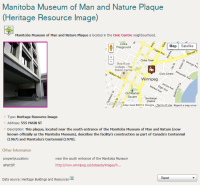
|
||
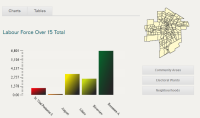
|
Graph StatisticsThe NOW site provides a rich set of Census statistics by neighborhood or community area for comparison purposes. The nearly half million data points may be compared between neighborhoods (make sure and pick more than one) in graph form (shown) or in tabular form (not shown). Census information spans from demographics and income to health, schooling and other measures of community well-being. Like all other displays, the selected results can also be exported as open data (see below). |
||
Image GalleryThe NOW portal presently has about 2700 images on site organized by object type, neighborhood, and historical. These images are contextually available in multiple locations throughout the site. The History topic section also matches these images to historical neighborhood narratives. |
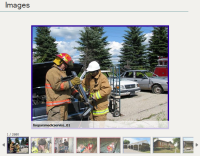
|
||
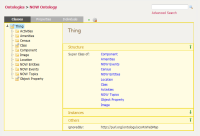
|
conStruct ToolsA series of twenty or so back office tools are available to City of Winnipeg staff to grow, manage and otherwise maintain the portal. Some of these tools are exposed in read-only form to the general public (see Geeky Tools next). The example at left is the structOntology tool for managing the various ontologies on the site. |
||
Geeky ToolsAs a means to show what happens behind the scenes, the Geeky Tools section presents a number of the back office tools in read-only form. These are also good ways to see the semantic technologies in action. The Geeky Tools section provides access to Search, Browse, Ontology, and Export (see next) tools. |
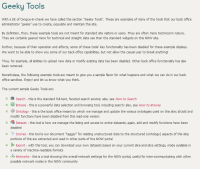
|
||

|
Open Data ExportsOn virtually any display or after any filter selection, there is an “export” button that allows the active data to be exported in a variety of formats. Under Geeky Tools it is also possible to export whole datasets or slices of them. Some of the key formats include: Some of these are serializations that are not standard ones for RDF, but follow a notation that retains the unique RDF aspects. |
||
Some Early Lessons
Though the technical aspects of the NOW site have been ready for quite some time, with limited staff and budget it took City staff some time to convert all of its starting datasets and to learn how to develop and manage the site on its own. As a result, some of the design decisions made a couple of years back now appear a bit dated.
For example, the host content management system is Drupal 6, though Drupal 8 is getting close to its own release. Similarly, some of the display widgets are based on Flash, which Adobe announced last year it will continue to maintain, but will no longer develop. In the two years since design decisions were originally made, the importance of mobile apps and smartphones and tablets has also grown tremendously in importance.
These kinds of upgrades are a constant in the technology world, and apply to NOW as well. Fortunately, the underlying basis of the entire portal in its data and stack were architected to enable eventual upgrades.
Another key aspect of the site will be the degree to which external parties contribute additional data. It would be nice, for example, to see the site incorporate events announcements and non-City information on commercial and non-profit services and facilities.
Conclusion
Structured Dynamics is proud about the suitability of our OSF technology stack and is impressed with all the data that is being exposed. Our informal surveys suggest this is the largest open data portal by a major city worldwide to be released to date. It is certainly the first to be powered exclusively by semantic technologies.
Yet, despite those impressive claims, we submit that the real achievement of this project is something different. The fact that this entire portal is fully maintained and operated by the City’s own internal IT staff is a game changer. The IT staff of the City of Winnipeg had no prior internal semantic Web knowledge, nor any knowledge in RDF, OWL or any other underlying technologies used by the portal. What they had is a vision of their project and what they wanted. They placed significant faith and made a commitment to master the OSF technology stack, and the underlying semantic Web concepts and principles to make their vision a reality. Much of SD’s 430+ documents on the OSF TechWiki are a result of this collaborative technology transfer between us and the City.
We are truly grateful that the City of Winnipeg has taken open source and open data quite seriously. In our partnership wth them they have been extremely supportive of what we have done to progress the technology, release it as open source, and then to document our lessons and experiences for other parties to utilize as documented on the TechWiki. The City of Winnipeg truly shows enlightened government at its best. Thank you, especially to our project managers, Kelly Goldstrand and Don Conolly.
Structured Dynamics has long stated its philosophy as, “We are successful when we are no longer needed.“ We’re extremely pleased and proud that the NOW portal and the City of Winnipeg show this objective is within realistic reach.






> NOW is entirely an ontology-driven site ( Graph Structure ) with both domain and administrative ontologies guiding all aspects of search, retrieval and organization.
Nice work Mike and Fred !